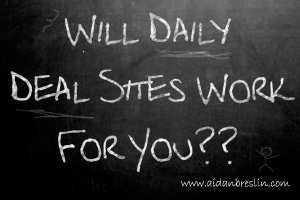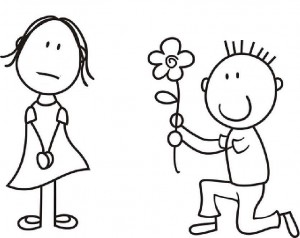Case Study of a Successful Groupon Marketing Campaign
 I’ve had a few people ask me about this over the past few weeks, and thought it would be useful to add it here also. This is a case study of a Groupon voucher deal I ran for a client in 2011, which I think is still relevant today.
I’ve had a few people ask me about this over the past few weeks, and thought it would be useful to add it here also. This is a case study of a Groupon voucher deal I ran for a client in 2011, which I think is still relevant today.
This was featured in the Irish Business Blog Bloggertone (now called Tweak Your Biz) on June 15th 2011, and in the Sunday Business Post on June 27th 2011 as an example of a successful Groupon marketing campaign (there’s a subscription required to see the Sunday Business Post version)
If you’ve ever thought about running a Groupon deal (or other voucher provider) to try to generate some additional business, then have a read, and as ever, comments welcome below.
Here goes:
Background:
Derrynoid Centre was a Conference & Training Centre with 40 en-suite rooms, restaurant & bar, leisure suite, nestled within a 250-acre forest in Draperstown (right in the middle of Northern Ireland)

The problem:
 The main customer base had historically been groups for conferences & training in the business, community and voluntary sector, with the subsequent spin-off from these groups for the accommodation / restaurant / bar.
The main customer base had historically been groups for conferences & training in the business, community and voluntary sector, with the subsequent spin-off from these groups for the accommodation / restaurant / bar.
On analysing occupancy rates I found that the centre followed the pattern for Northern Ireland B & B Occupancy rates, except for during the holiday periods (in particular Summer and Easter). During July & August 2010, the NI Average occupancy was 43% and 48% respectively, whereas theirs dropped to 6% and 10% in comparison, due to an over-reliance on the Conference and training market.
The objective:
 They wanted to promote their B & B business to the tourism & leisure sector, as they were ideally suited to that market, and it would also allow them to even out the seasonal fluctuations in demand in the conference / training sector.
They wanted to promote their B & B business to the tourism & leisure sector, as they were ideally suited to that market, and it would also allow them to even out the seasonal fluctuations in demand in the conference / training sector.
To address the imbalance, it was identified that they had an excellent product offering, but their issue was one of limited brand awareness.
We identified Groupon as a vehicle for reaching a large audience very quickly, with an immediate impact.
After researching the downside of this type of voucher offer, I was confident of making this work, and sat down with the client and set the objectives for the campaign:
- Raise awareness of the facility within the B & B market in NI
- Retain the ability to upsell any customers who booked through Groupon
- Develop a customer retention program for all Groupon deal purchasers to encourage a second visit.
- Encourage TripAdvisor reviews to further enhance our marketing opportunity, and brand awareness
The deal:
Upon contacting Groupon, I was impressed and found them to be extremely professional – they are a well-oiled marketing machine. With their help we put together a deal (see graphic above) based on an experience for customers (Dinner + Wine + Bed & Breakfast).
The discount was set at 61% (their minimum for our sector is 60%), which with their fees (50% + VAT) left the deal just below break-even point for every voucher sold, but which the client were prepared to do  for the new customer acquisition.
for the new customer acquisition.
The deal was set so that if someone wanted to come here and not spend anything else, they would have a really good experience just with the Groupon deal.
However we anticipated that a percentage at least would have such a good experience that they would spend extra on further wine / drinks / dessert / extra nights accommodation, which is exactly what happened (see results)
We built in several opportunities for upsell during the customer journey (which did not attract the Groupon commission, so they retained 100% of this income)
- When they rang to book, they were offered a second night at a discount rate
- The meal included a glass of wine, any further drinks were additional
- The meal was 2 course starter and main – dessert was additional
- When they checked out they were asked for their email address, and told by check out staff that they would receive an offer to come back for a second visit. The majority were happy to receive this, and the re-book rate worked well for the centre.
After also reading the horror stories of other offers (on both the business side and the customer side, we decided on the following:
- We would be as prepared as possible for an increase in call volume when the vouchers became active
- There would be no restrictions as to when voucher holders could book (midweek or weekend)
- Every Groupon voucher customer would be treated exactly the same as a full-paying customer
The live day:
The deal started 8/3/11 as a side offer and trundled along nicely, selling approximately 2 per hour. During the day it then moved to be the main feature, and then started to really move – ending up selling 426 vouchers by the time the offer closed, with which we were all delighted.
The voucher active day:
The vouchers became active on 11/3/11, and the phones rang off the hook for 2 days (nice problem to have but I was conscious that this was one of the main bugbears of voucher buyers – that they can’t get through to make their reservation). The Reception staff worked very hard returning a lot of answering machine messages during the next few days to try and ensure everyone was sorted.
We put a very simple system in place for collecting the various reference numbers required, and forwarding them to Groupon regularly to make the claim for reimbursement. They paid vouchers for holders who have made a reservation within 5 days of claim, and I found them to stick pretty close to this (maybe a day or two after, but no later)
The review:
At the time of writing (June 2011) they had an 88% redemption rate on the vouchers, most of whom had completed their visit. They had taken an average of 31 Groupon vouchers (i.e. 62 customers) per week since the offer went live, and their bar and restaurant takings were up by 26% over last year.

- We added virtually every Groupon visitor to a newly created email database to receive further offers, and upon the first email offer to these subscribers, they had a 12% uptake for these customers to book again to revisit (at that time according to Groupon, the average re-book rate was 2-3%)
- Before they started we had 1 review on Tripadvisor, at time of writing there are 21 and counting, with the vast majority being very positive.
- As another benefit from the offer, several of the Groupon guests were members of various large organisations who use off-site conference and training facilities, and the client are now able to pursue these much more effectively than they would if they had to start with a cold call.
- Some people came and spent nothing additional and had a good experience. If you’re going to go down this avenue, that will happen. However many came and spent more when they were there. The average additional spend per voucher was £27.50
- All in all Groupon worked very well and achieved all the objectives we had set. It can be extremely effective at delivering a huge amount of extra customers, but you just need to have a clear strategy as to what to do with those customers when they visit, and then afterwards to make it work for your business.
(We have just completed our second Groupon voucher offering, where we sold 255 vouchers in 2 days (slightly higher price this time). This time we learned from our previous experience and Groupon set in place for us an online booking system for customers’ convenience so that we wouldn’t have the huge call volume and frustration at not being able to get through.)










